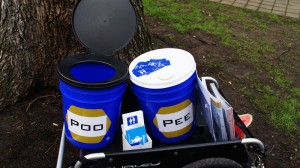What are you going to do when your toilet doesn't flush or you don't have access to one?
Imagine a "mega-quake" scenario in your region. Try a best case scenario: the quake hits early on a Sunday morning when members of your household are together and accounted for. Your house is damaged but several rooms are usable; you can shelter in place. You have stockpiled food and drinking water for the first month. More worrying is the fact that you don’t have running water and your toilet won’t flush. Your water and sewer pipes must have broken somewhere along the line.
Professional emergency responders may come to your rescue, but it will probably take a while. They’ve got damaged bridges, unsafe roads, downed electrical and phone lines, and, most importantly, injured people to worry about.
Without potable water, people can die within a week. Supplying it will keep teams busy, and if you're prepared, you will have some extra water on hand. But managing your household pee and poop? You can do it yourself if you’re prepared! All it takes is a couple of buckets and some mulch.
Use the Twin Bucket Emergency Toilet!
What is the Twin Bucket Emergency Toilet, and how does it work?
This flush-less system requires minimal materials and maintenance. One bucket is used for pee (sterile), and the other is for poo -- be sure you don't mix the two! Toilet paper can be tossed in the poo bucket. After going #2, cover the entire surface of the poo with carbon material (mulch, shredded paper, coffee grounds, sawdust, etc.) and close the lid. No mixing necessary!

Twin Bucket Emergency Composting Toilet.
Has this system been used before?
Yes! Our Twin Emergency Bucket Toilet guide was inspired by the compost toilet group of New Zealand Permaculture Emergency Response Group, which used the Twin Bucket system to serve residents of Christchurch after the February 2011 earthquake. With their permission, we took their simple innovative approach and urged Portlanders to prepare. The City of Portland adopted the Twin Bucket Emergency Toilet in fall of 2011.
Now the Twin Bucket toilet has been adopted throughout the counties of Oregon and Washington that make up Greater Portland. New materials are posted at www.emergencytoilet.org.
As Internet access is likely to disappear following a major seismic event, print our Twin Bucket Emergency Toilet leaflet to put with your emergency supplies. Printed on both sides of a single sheet it can be folded into a six-panel leaflet. You are welcome to adapt it for your neighborhood or group using this template in Word. You can add your group’s logo or that of a sponsoring local business. Kindly retain the small acknowledgements box.
Make your own Twin Bucket Emergency Toilet
Here’s what you need for the toilet
- Plastic buckets (5 or 6 gal. size; 3.5 gal buckets are good for kids)
- Lids for buckets
- Some kind of a toilet seat.
- Carbon material: A brick of coir fiber from a garden store or 1 or 2 gal. Plastic bags of coarse sawdust, shredded paper, coffee husks, or dry leaves.
- Paper copy of the Twin Bucket Emergency Toilet leaflet
Add these for a complete kit
- Toilet paper
- Hand sanitizer
- Disposable plastic gloves
- Wipes, sanitary napkins, tampons and diapers as required
- Paper copy of A Sewer Catastrophe Companion so you can manage your toilet longer term
Think containers! The Twin Bucket toilet is part of a container-based sanitation (CBS) system. For emergency systems, all sizes of plastic containers are useful. Five, six and seven gallon buckets are ideal are ideal for the toilet. Three and four gallon buckets usually discarded by bakeries come with good lids and work for well for toilets for small kids.
A full CBS System would ideally also include a Handwashing Station. Several examples are shown on our visual handwashing station guide and our list of handwashing resources. Note that DIY handwashing stations use a variety of containers, such as 55-gallon barrels, wheeled recycling barrels, 5-gallon buckets, or other lidded containers. These can be used to store clean water, greywater, and various supplies, so keep your eyes open for plastic containers and collect and store as many as you can. Nested buckets don’t take up much room.
For more help finding materials, preparing, and using your system, visit Set Up and Use Your Emergency Toilet.
For more information on the Twin Bucket system, visit the Twin Bucket Toilet FAQ.
Subscribe to our newsletter!
Newsletter Subscription
Research with MFA student Keliang Li Pee Curl, or public urinal for men, in Amsterdam On a recent trip to Amsterdam, when I asked a local shop owner where I could use the restroom, she told me there were plenty of places for men but…
Written with MFA student Tong Zhao Proposed public toilet, called a Sanisette, near Eiffel Tower in Paris With all the coffee and wine you’ll be drinking in Paris, it’s good to know there are plenty of free public restrooms. Cafes are everywhere in Paris: go…
Written by MFA student Jean Juan with Margot Kleinman North Bondi Beach Restroom The City of Sydney, one of Australia's largest and fastest-growing local areas, has an estimated population of 5.2 million in 2024. (https://worldpopulationreview.com/world-cities/sydney-population). In the 2022/23 financial year, the city hosted 5.4 million…
Public Toilets Case Studies with Pratt Institute: Amsterdam, Netherlands
Public Toilets Case Studies with Pratt Institute: Paris, France
Public Toilets Case Studies with Pratt Institute: Sydney, Australia
[show_twitter_feed]
